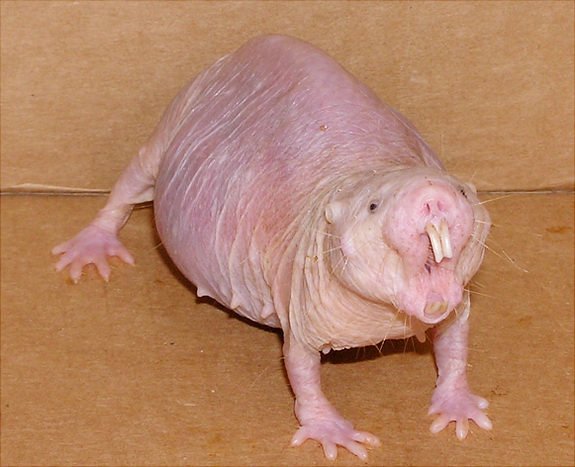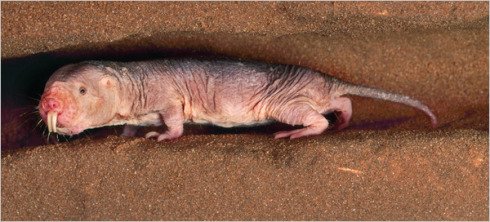
There is a plethora of reasons why I find the naked mole-rat the most interesting animal:
General description
The naked mole-rat (Heterocephalus glaber) is a rodent that is native to the drier parts of tropical grassland of East Africa, predominantly in Ethiopia, Kenya and Somalia.
The naked mole-rats live in large colonies (50-200 animals) underground. They are the first mammal to exhibit eusociality, and they live in ant-like colonies, complete with queens and workers. Just some of the rats are fertile while the rest are workers.
Typical individuals are 8 to 10 cm long and weigh 30 to 35 grams.
Queens are larger and may weigh up to 80 grams.
Eusociality is the highest level of organization of animal sociality, and is characterised by cooperative brood care (including brood care of offspring from other individuals), overlapping generations within a colony of adults, and a division of labor into reproductive and non-reproductive groups.
They are master miners
They make very large and complex underground tunnels.
Their legs are very short and the can move backward as fast as forward. They use around 25% of their energy on closing their jaws while they dig.

Physiology
The naked mole-rat is very well adapted to living underground with low oxygen levels. They do have very small lungs, but their hemoglobin has an extremely strong affinity to oxygen.
Thus, the naked mole-rat can survive in air that contains only 5% oxygen for 5 hours!
One of the reasons is that they can lower their heart rate from 250 to 50 beats per minutes during anoxia.
They are also almost ectothermic (cold-blooded), meaning that they regulated their body temperature according to the environment.
The glycolysis is fructose-driven and give anaerobic glycolysis by a rewired pathway that avoids tissue damage. Science, 2017
Diet
The naked mole-rat feeds on very large tubers. A single tuber can provide a colony with food lasting for months, or even years, as the rats eat the inside but leave the outside intact, allowing the tuber to regenerate

They are highly resistant to cancers
Even though scientists have used every ‘trick’ in the lab to induce cancer (radiation, various toxins), no one has actually been able to spontaneously induce cancer or seen a naked mole rat with a tumor.
One of the main reasons are probably that the naked mole-rat expresses an extremely high molecular mass hyaluronan (HMW-HA) that is over 5 times larger than hyaluronan in humans. Nature, 2013
The extremely high molecular mass hyaluronan makes the skin very loose and stretchy. This allows it to move through tight underground tunnels without ripping its flanks as it rubs against dirt and rocks.
One mechanism why HMW-HA can prevent cancer is due to the fact that HMW-HA makes the mole-rats cells hypersensitive to contact inhibition by stimulating an intracellular pathway that induces expression of p16 and suppresses oncogenic transformation. J Cell Commun Signal, 2015

They also have ribosomes that make almost error free proteins. PNAS, 2013
They live long
The naked mole-rat can live up to 30 years, much longer than other similar size rodents.
The reasons for this is probably complex, but they do express much more DNA repair genes than other rodents, so they can keep their genome healthy longer.
As stated previously, the rarely get cancer.
Interestingly, they have a very low metabolism during harsh times with low oxygen levels, and lower metabolism reduces oxidative stress.
They do not feel pain
Naked mole rats lack substance P, which is a key transmitter for sending pain signal to the CNS. J Comp Neurol, 2003
Thus, without substance P capsaicin has no pain mediating effect, so this rat can eat hot chilli effortlessly!
Also, I suppose it would be very unpractical to feel pain if you constantly rub your skin against dirt and rocks.
Conclusion
The naked mole-rat is a really strange animal, but is extremely well adapted to its environment.
For example, this rat could be very good animal model for studying metabolism and anoxia.
The role of the extremely high molecular weight hyaluronan (HMW-HA) in preventing cancers in this rat, is very interesting.
Hypothetically, HMW-HA could be used as nano-therapy.
Also, by further studying the mechanism involved in cancer protection, this could elucidate novel targets for therapy against various cancers in humans.
References
Scientific papers as cited
Wikipedia.org
